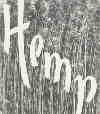
|
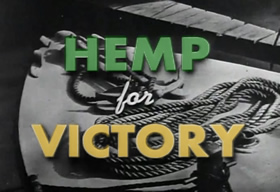 DURING THE SECOND WORLD WAR |

|
|---|
THE OPPOSITION
VOICES OPPOSED TO AMERICA’S WAR EFFORT
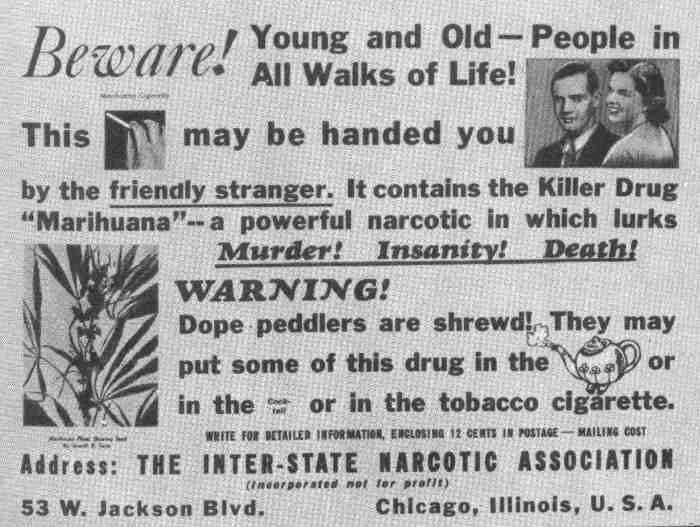
One of the main groups opposed to growing Industrial Hemp for the War effort was the "Inter-State Narcotics Association," or the same clowns who put together the (above) poster; -- Today known, for whatever reasons, as the "Friendly Stranger Poster".
MARIHUANA
DISENTANGLEMENT OF TRUTH FROM FALSEHOOD
IN THE STUDY OF CANNABIS SATIVA

Yes, there were those who were oppose to America’s WW2 Hemp-For-Victory program.
So, where these individuals axes saboteurs? Did they deliberately want America to loose the war? Or just idealist and/or nut cases who truly believe that Marihuana (in any form), was truly the Weed Of Madness. Here, instead of us interjecting our own opinions on the subject, we felt that it might be best to simply allow them to (as much as possible) speak for themselves sort to speak. And to allow them to do so in their own words.
The following article (containing a sub-article within it), was obtained from a book published by the “Inter-State Narcotics Association”. We reprint it here mostly because it represents the viewpoint of those who were opposed to the war’s Hemp-For-Victory program, but also because it contains the viewpoints of so many other involved parties at the time.
WARNING: --- Some (in fact a lot) of the information contained within is somewhat in error. Even the pro-Industrial Hemp (sub-article) while more or less being correct also seems to contain minor technical errors.
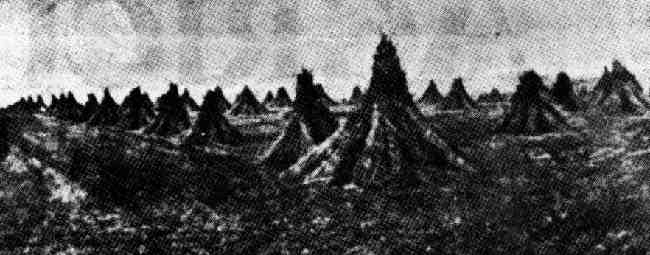
“These look like wigwams - but they are the retted hemp on one of the heavy yielding fields of Wisconsin”
MARIHUANA
DISENTANGLEMENT OF TRUTH FROM FALSEHOOD IN THE STUDY OF CANNABIS SATIVA
NOTE that this article begins with the reproduction of another article as taken from the Mar. 6, 1943 issue of the Wisconsin Agriculturist & Farmer; -- which itself had written a pro-Industrial Hemp article. It then goes on to address their concerns about Industrial Hemp through their own viewpoint.
(By Questions and Answers)
– Taken directly from the Wisconsin Agriculturist & Farmer:
(An attempt to clarify obscure statements as regards terminology (name), potency, physical and mental effects of the use of marihuana (Indian hemp) on the human system to FORESTALL seemingly diabolical untruths which are already in circulation apparently to mislead the uninformed public to believe that the vast acreage of “common” hemp (cannabis sativa) now being grown for fiber with government permit to meet the war need, is not the “wild Indian hemp,” that is smoked illicitly in cigarettes for their neurotic effect, but that it is a different plant of the same family and without narcotic effect.
Q. 1 --- What occasioned this critical analytical investigation of the reports of the findings on Cannabis sativa (Indian hemp)?
A. --- The following starting article which was published March 6,1943, in the Wisconsin Agriculturist and Farmer, given 11 points covering definite instructions for growing Indian hemp for fiber as published and distributed under the Act of Congress, may 8, 1914, by The Agricultural Extension Service, College of Agriculture of the University of Wisconsin, Warren W. Clark, director, the United States Department of Agriculture cooperation.
SOME HELPS ON HEMP
Answering Your Questions on Wisconsin’s New War Crop
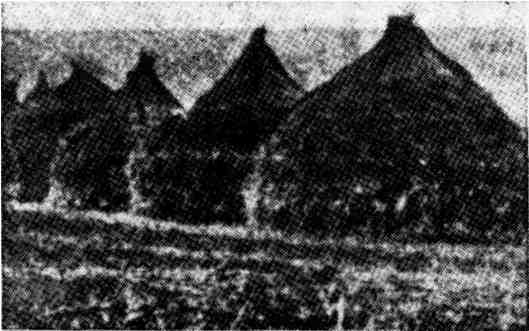
“Like chocolate drops - these stacks of retted hemp are ready for hauling to the processing plant.”
“Because Uncle Sam had his supply of cordage and rope fiber snapped up by the Japs in the South Pacific, he asks that American farmers grow 30 acres of hemp where one acre was harvested in 1942. Plenty of milling and harvesting facilities will be provided.
“Because Wisconsin pioneered the hemp business and has been the biggest hemp center for 25 years, our farmers will be in a good position to expand from 8,000 acres to 40,000 this year with little difficulty. We will have six new mills.
“It’s a race for supremacy between the negro slave labor under the lash of Japanese rule in the East Indies and our own hardy and capable midwest farmers. The following short sketch of elementary points in hemp culture by question and answer method is a start to help us get ready. For more details send for Wisconsin Circular on hemp, Agricultural Extension Service, Madison.1. “Will Sand Marsh Land Do? No; uniform, fertile upland prairie silt loam or the best of fertile clays are necessary. Rocky, gravelly, marshy and peaty soils or thin blow sands are absolutely not suitable. Hemp soil wants plenty of rich organic matter too.
2. “Is Hemp Tough On Land? No; it takes out just about the same fertility as a good corn crop, and its luxuriant growth does not signify that it is a terrific feeder. Wisconsin growers say hemp helps control noxious weeds well and gives the soil physical benefits.
3. “What Pests Injure Hemp? Hemp is not immune to attacks of insects or fungi, but it is not usually hurt much. On spring plowed land cut-worms and grubs may hurt seedlings. European corn-borers attack growing hemp, and sometimes a fungus hurts the roots if the spring is very wet. Hail is the worst enemy.
4. “How About Rotations? Hemp does best after corn, alfalfa, clover or bluegrass pasture, but as a rule it does not thrive well after timothy and small grains. Only on highly fertile soils should hemp be grown two years in succession on the same acreage.
5. “How About Extra Fertilizer? Barnyard manure supplemented with a complete commercial mixture is good, such as 3-9-18 or 3-12-12. Applications of 300 to 400 pounds of 20 percent superphosphate helps on black prairie land. Lime, three to four tons an acre, on acid soils will be helpful too. Using mixed fertilizer without organic matter furnished by manure or legumes turned under is not apt to be dependable.
6. “Is Seed Bed Important? Yes; a uniform, well worked seed bed pays. Fall plowing is a trifle better, althought spring plowing will do. Good disking and harrowing is important as the soil mush be firm and compact. Use a corrugated roller before and after seeding.
7. “What’s The Seeding Practice? Growers will get seed through their War Boards or mills, and Kentucky seed is more reliable than foreign. Seeding is done between oats and corn time, with broadcast seeder or grain drill. The broadcaster is better if corrugated roller is used before and after. On still clays the broadcast method is best and on loose, friable land use a drill. Use four-inch drill preferable, but never an eight-inch drill. Depth of planting should not exceed an inch. Rates are not less than four pecks and usually about five, or 44 to 55 pounds an acre.
8. “Is Hemp Small Labor, Weedless Crop? Growers who think that hemp will handle the weed invasion without help are mistaken. Unless land has been put into good shape to check quack and thistles, they are apt to overcome the hemp. But if given a good start hemp does tend to crowd out weeds
9. "When Is It Harvested? When the pollen bearing plants are in bloom. The top will be yellow and the lower leaves dried and fallen. There is a period of three weeks between blossom and seed formation in which cutting is done. Avoid over-ripe hemp as it does not ret well and makes a coarse fiber. Special harvesters are used.
10. "What Is 'Retting’? -- It probably comes from “rotting,” because the object is to decompose the bark and stems so they will easily separate. In warm moist weather retting occurs nicely in 15 days. In dry, cool seasons the crop may have to stay flat in rows where it was laid by the harvester for some time. Growers say it pays to leave the stalks this way even until snow flies rather than to lift it before it is in proper milling condition. The straw is turned in the field in cases of delayed retting.
11. "Then What Follows? When the straw is well retted it is lifted with a special picker (furnished by the mill) and bound in bundles. The bundles go in shocks a bit larger than corn shocks, but much the same shape. After curing awhile this way some farmers put the bundles into conical stacks in the field or barnyard, or they may arrange to haul the hemp direct from shocks to mill yard. Hemp is processed better after stalks have been left in stacks awhile. In stacking hemp, aim to keep the center high, and give the bundles a steep pitch, with as little weathering as possible of the butts. The farmer’s job ends with the delivery of properly matured hemp of good fiber. The rest is the job of the miller.
[A MISCHIEVOUS INSERT (Interstate Narcotics Ass.) ]
12. "How About 'Marihuana?'” Yes, some folks shouted loudly about that menace of wild hemp used for cigarette smoking a few years ago--when there was nothing worse to write about. (This paper didn't get excited much.) However, just to be safe on the legal side growers will be furnished with permits when they sign up to raise fiber, which excuses them from liability under the "awful" marihuana menace. Unless tobacco gives out it's not likely that many of our youngsters will fool around rolling themselves hemp cheroots.
Final Act---Milling
“In the Wisconsin hemp mills, the retted straw is put through long drying kilns. This removes practically all the moisture. The dried straw is then thoroughly crushed by a machine known as a "hemp brake." After the straw is crushed, the broken material is cleaned by brushing and is combing. This process is known as "scutching," and the machine on which the work is done is known as a "hemp scutcher." The long fiber as it comes from the scutcher, twisted into “hands” ," graded, and baled. This long, straight fiber is known as "line." In scutching, a part of straight fiber is brushed and combed out with the woody portion of the plant. This part of the fiber is short, tangled, and snarled, and is known as "tow." Such fiber is also produced from short or tangled stalks. The tow is cleaned and prepared for baling in a special machine. It is not twisted into "hands" but is baled in the form in which it comes from the tow machine.' * * * -------------
Q.2 --- Why was “point 12” inserted?
A. --- That is what investigators are trying to determine. It seems to supplant the following footnote that appears in the Wisconsin circular on hemp growing, which is published by published by the Agricultural Extension Service, Madison, Wisconsin:
[This should have been Point 12 (Interstate Narcotics Ass.)]
“Federal Narcotic License Necessary. All growing hemp plants contain a narcotic substance known as ‘marihuana.’ Because of this, all hemp producers and all persons possessing and transporting hemp seed shall first obtain a federal license as required under the provisions of the Marihuana Tax Act of 1937. Information is usually available from Internal Revenue Officers from managers of hemp processing mills. “[The above was omitted. (Interstate Narcotics Ass.) ]
Q. 3 ---Has the Editor of the Wisconsin Farm Paper been reproached for his apparent ridicule of the widespread verbal, written and printed warning messages that have been circulated against the use of Cannabis sativa (Marihuana) which is declared to be the most "virile poisonous stimulant" known to science: pamphlets, booklets and volumes have been published and circulated by the Opium Research Committee, Foreign Policy Association, The World Narcotic Defense Association, professors of pharmacy, and heads of State Departments of Education throughout United States?
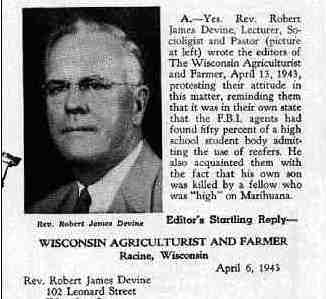 [ Rev. Robert James Devine ] Author of the book on the right |
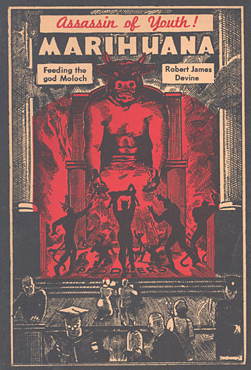
|
A.--Yes. Rev. Rev. Robert James Devine, Lecturer, Sociologist and Pastor (picture at left) wrote the editors of The Wisconsin Agriculturist and Farmer, April 13, 1943, protesting their attitude in this matter, reminding them that it was in their own state that the F.B.I. agents had found fifty percent of a high school student body admitting the use of reefers. He also acquainted them with the fact that his own son was killed by a fellow who was "high" on Marihuana
Editor's Startling Reply--
WISCONSIN AGRICULTURIST AND FARMERFollowing receipt of this letter, Mr. Devine, who is the originator of the Internationally known series of “Map Messages Dealing Solely with Youth Problems And Their Scriptural Solution,” and whose slogan is “As Goes The Child, So Goes The Nation,” was conducting a campaign of education and warning in Minneapolis, Minn., and sent the following Air Mail message to the Inter-State Narcotic Association, Excerpt follows:
Racine, Wisconsin
April 6, 1943
Rev. Robert James Devine
102 Leonard Street
Waterloo. Iowa
Dear Reverend Devine:
“We have your good letter of April 2, and appreciate your stand as well as our seeming indifference to an important matter. We also want to sympathize with you on your terrible experience.
"What we should have said was that the common hemp Cannabis sativa is not the wild Indian hemp from which the vile resin is obtained to make hashish. The marihuana is a different plant of the same family as the common hemp and is often confused with it.
"In other articles in previous years we have gone over this matter thoroughly enough so that our readers understand the menace of this evil. But it must not be confused with the growing of common hemp for fibber. One could smoke leaves of common hemp all day without any bad reaction.
“Again we assure you that we are with you in all good work and regret that the idea should have been expressed that we are indifferent to any such evil.”
Yours truly
(signed) F.B. Swingle
Editor.
“The Wisconsin Agriculturist and Farmer has stated confidently that the Indian hemp that will be grown under government supervision has no narcotic potency. Is this true? Can you confidently contradict such as statement? I wish I might know, for I wish to warm Christian parents of this dangerous drug as a part of my message and I am not in a position to answer this question without some authority. Is the government-grown hemp the same as the hemp from which reefers are made? Does it become potent after it has reached the blossom and seed stage? I shall greatly value your early reply. I am not an authority, but my work does give me an opportunity to warn others.Q. 4 --- Is the government-grown hemp the same as the wild hemp that is illicitly smoked in cigarettes?
“Please enter my subscription to the Narcotic Review. May I have a copy of the April, 1940, issue? Mail my regular issue to 102 Leonard Street, Waterloo, Iowa.”
Yours,
(Signed) Robert James Devine.
Minneapolis, Minn.
April 11, 1943
A. --- Hon. Lawrence Kolb, Assistant Surgeon-General, Answers:
FEDERAL SECURITY AGENCYDr. KOLB’S FINDINGS SUBSTANTIATED by Dr. Frederick T. Merrill, Opium Research Committee, Foreign Policy Association
U.S. Public Heath Service
Washington, D.C.
July 19, 1943
Mrs. Alice Hyatt Mather
Executive Secretary
Inter-State Narcotic Association
Chicago, Illinois
Dear Mrs. Mather:
“Replying to your letter of July 15, asking about the narcotic properties of the Indian hemp that is grown for fiber in this country, you are advised that all types of Indian hemp, including that grown for fiber, have some of the narcotic principle. However, available information indicates that hemp grown in this country is not as potent as some that is grown in others.
“Of course, you understand that the fiber part of the hemp cannot be used for narcotic purposes.
The narcotic principle is contained in the flowering tops and to some extent in the leaves.”
Very truly yours
(Signed) Lawrence Kolb
Assistant Surgeon-General
Division of Mental Hygiene
“There is only one species of the hemp plant, Cannabis sativa L. Certain distinguishable differences in plants grown in different countries have been noted, but they have been noted, but they have not been sufficiently definite to indicate varieties in the botanical sense. From the agronomic point of view, however, recognizable variation occurs, induced in part by difference in environment.Q. 5 --- Does Marihuana become potent after it reaches the blossom and seed stage?
“Apparently, regardless of locality of growth, this plant produces the narcotic principle in varying amounts. Moreover, the findings of experts abroad, who have been experimenting under the auspices of the League of Nations, that all parts of the plant, except the roots, pitch and lower stalk, and even young plants three inches high, are capable of producing traces of the resin.” --- From Dr. Merrill’s wonderful book, “Marihuana, The New Dangerous Drug.”
A. --- According to Dr. Merrill, the very young (three inches high) contains the narcotic principle, but naturally, as the plant develops, it would increase in potency and especially is this true in the blossom and seed stage.
Q.6 -- What does the term Cannabis sativa Indica imply?
A. --- That reference is made to the plant as grown in the Orient.
Q.7 --- What does the term Cannabis sativa Americana imply?
A. --- That reference is made to the plant as grown in the Western Hemisphere.
Q.8 --- What is the origin of the name Marihuana?
A. --- Marihuana is a slang word of Mexican-Indian origin, (the weed that intoxicates.) It has been employed primarily to designate those parts of the pant, or those derivatives whose potency in terms of combined narcotic principle was high. Therefore, since the bulk of the resin is found in the upper leaves and the flowering tops, the term marihuana has been relatively limited to those portions of the plant.
Q.9 --- By what name is this intoxicating weed recognized in the United States?
A. --- In the United States official recognition has been accorded to the designation marihuana, and it has been defined by statute, as all parts of the plant Cannabis sativa L. (Linne) family name of the plant, whether growing or not. *** The definition is obviously designed to be of sufficiently wide scope to include not only the portions of the plant which are used as a narcotic but also, the seeds capable of producing themselves. (Merrill)
Q.10 --- What is Hashish?
A. --- Hashish is the Arabic name for a narcotic preparation made in the Orient from hemp --- a special form of recovered resin of the hemp plant. (Nat’l Encyclopedia.)
Q.11 --- Can one become addicted to the use of marihuana?
A. --- While marihuana does not cause the physical withdrawal pains of opium, morphine and heroin and other derivatives of opium, it does give a feeling of acute physical discomfort and extreme nervous distress that forces the user to continue use of the drug. (Rowell.) The withdrawal phenomenon is what the medical profession describes as a symptom of addiction. Nevertheless, the continuous use of marihuana does give rise to a form of addiction, amounting to at least a craving. (Merrill.) This marihuana charm is referred to by other authorities as a mental fascination that is peculiarly compelling.
It is reported that there are marihuana users who claim that they can quit the habit at any time and suffer no bad physical effects. But it is seldom that one discontinues the use of the drug in its entirety, and the marihuana craving seems to be latent and under unusual circumstances crops out from time to time. The mental fascination of past marihuana experiences is parallel in its hold on its victims to that of the cell-hunger that grips the users of tobacco and alcoholic liquors. It is only at the end of their drug career can they know the dire effects and misery that await in store for them.
According to Robert P. Walton, in his 223-page volume, “Marihuana, America’s New Drug Problem,” the chronic effects of the use of hashish (marihuana) are primarily the same in all countries, and the manifest differences are accountable to the variances in potency of the drugs available, and the difference in temperament of the people at large, and the environment in which they live and move.
In the East where the hashish vice has been made a study throughout the ages, conclusions with reference to the virility of the “killer weed” have been drawn which should have considerable weight in solving the problem in the Western Hemisphere, and especially so is this true, since the vice in different countries is at variance only in minor particulars.
Of the few reported cases of marihuana addiction among the more intellectual class of people, is that of Fitzhugh Ludlow. The story of his life reveals that he claimed that there were no physical impulses that impelled his return to the drug, but the mental fascination of his past hashish experiences was under certain circumstances so impelling that it was exceedingly fortunate that hundreds of miles intervened between him and the nearest supply of hashish, for otherwise, he would have had his drug even through it was necessary to “swim a whirlpool on the way.” This throws light on the impelling force of the marihuana charm.
Further echoes from the Old World should have bearing on America’s New Drug Problem: From Brazil. --- Hashish (marihuana) smoking among the Brazilians is a real addiction; like reports come from Turkey; more than three score cases reported in Russia, who exhibited withdrawal symptoms to a remarkable degree. The majority were between 15 and 25 years of age --- a vice of the younger generation.
Q.12 --- Can one predict what may be the effect of even one reefer?
A. --- No prediction may be made as to the effect of even one marihuana cigarette. Observation and experience have proven this to be true. “The smoking of one reefer so violently upset one individual that he became a homicidal menace to society. Therefore it may be concluded that the Cannabis principle in American Marihuana is often DANGEROUSLY POTENT.” Moreover, each individual reacts differently toward equal doses of this narcotic, depending on his racial, physiological and emotional constitution and on the unpredictable quality of the poisonous resin contained in the marihuana he uses. (Merrill.)
Q.13 --- Has crime or crime tendencies been traced to the use of Marihuana?
A. --- The World Defense Association has issue a warning to the public at large, without copyright, in which it states:
“While the marihuana habit leads to physical wreckage and mental decay, its effect upon character and morality are even more devastating. The victim frequently undergoes such moral degeneracy that he will lie and steal without scruple; he becomes utterly untrustworthy and often drifts into the underworld where, with his degenerate companions, he commits high crimes and misdemeanor. Marihuana sometimes gives a man the lust to kill, unreasonably and without motive. Many cases of assault, rape, robbery and murder are traced to the use of marihuana.Throughout the ages seductive influences of hemp have been awarded extravagant praise along with the bitterest condemnation, but thoughtful study of this rapidly spreading vice reveals it to be one of the curses of modern civilization.
“In the latter stage of the intoxication caused by this “Killer weed,” the intense over-excitement of the nerves and emotions leads to uncontrollable irritability and violent rages which in most advance forms cause assault and murder! Illusions pass into hallucinations (a temporary state of insanity) that had cause horrifying murders. *** The drug has a corroding effect on the body and on the mind, weakening the entire physical system and often leading to insanity.
“It is true that in some cases the drug is only a contributory factor and not the direct cause of the crime. There are many instances, however, in which marihuana has been more than an adjunct to the criminal act, in fact, it has been responsible for the crime itself. Certain cases have been called at random from the files of the United States Bureau of Narcotics to illustrate the homicidal tendencies and general debasing effects which arise from its use.” (Merrill.)
It is an established fact that every known evil maintains a vast army of friends who are unrelentless in giving unwavering support to a conjured defense which has been built up to maintain that evil. This is done without thought of the unpredictable suffering that may thus be wrought to humanity.
The seared conscience seeks only self-gratification and money profit. The most serious aspect of the marihuana vice is the extent to which it leads to child delinquency. -- Editor
MUSEUM COMMENTS:
Thus as can be seen, the individuals/organizations noted above seemed to have been acting out of actual concern for America as oppose to expressing support for the Axes powers. To them they believed that Marihuana did indeed make you into a cold blooded killer and thus growing a lot of Industrial Hemp (by increasing the supply) that no good could come of it. There reasoning probably being something like; The more marihuana, the more users and the more users the more cold blooded murders that would occur and America’s war effort would be harmed as opposed to helped.
Of course we know better now, but back then . . . hadn’t that been what there own Federal Government had been telling them? And would our own government lie to us?
WANT TO KNOW MORE:
=====================
Due to space / download time considerations, only selected materials are displayed. If you would like to obtain more information, feel free to contact the museum. All our material is available (at cost) on CD-Rom format.
CONTACT PAGE
 BACK TO SECTION IV |